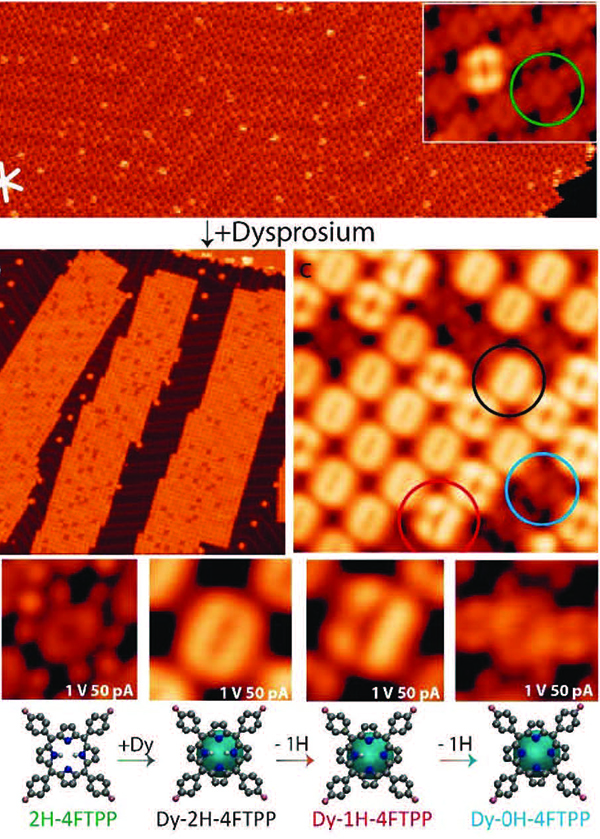Tailoring the Kondo effect: one molecule at a time
06.05.2021
- Researchers manipulate the Kondo resonance of lanthanide-porphyrin nanoarchitectures through tip-induced chemistry.
- This research result funded by the ERC manifests the potential of tip-induced coordination chemistry for spintronics.
 The design of molecular systems on surfaces is crucial for the fundamental understanding of electronic transport. The development of molecular electronics, spintronic devices and quantum computation will only happen along with the precise control over the spin texture and its interaction with the surroundings. The Kondo effect is a phenomenon that has attracted much attention because of its potential in single-molecule spintronic applications. The Kondo effect results from the interaction between spin of magnetic impurities and the conduction electrons, resulting in a change of electrical conductivity below certain temperatures. This phenomenon has been extensively investigated on surfaces, particularlly in metal macrocycles; however, the magnetism of lanthanide coordination complexes are largely unexplored.
The design of molecular systems on surfaces is crucial for the fundamental understanding of electronic transport. The development of molecular electronics, spintronic devices and quantum computation will only happen along with the precise control over the spin texture and its interaction with the surroundings. The Kondo effect is a phenomenon that has attracted much attention because of its potential in single-molecule spintronic applications. The Kondo effect results from the interaction between spin of magnetic impurities and the conduction electrons, resulting in a change of electrical conductivity below certain temperatures. This phenomenon has been extensively investigated on surfaces, particularlly in metal macrocycles; however, the magnetism of lanthanide coordination complexes are largely unexplored.
Researchers at the Nanoarchitectonics on Surfaces Group at IMDEA Nanociencia, led by Dr. David Écija, have recently published their work on lanthanide-porphyrin species in the RSC journal Nanoscale. In their publication, researchers prepared dysprosium (Dy) porphyrins on a gold surface and studied their Kondo effect. Porphyrins are macrocyclic organic compounds with interest as pigments, catalysts and in molecular electronics. The researchers were able to switch off the Kondo resonance by removing one hydrogen atom of the macrocycle through tip-induced voltage pulses with submolecular precision.
The work led by Dr. Écija combines the on-surface design of 2D reticular porphyrin nanomaterials, coordination chemistry of lanthanides, low temperature scanning tunneling microscopy and spectroscopy with theoretical DFT calculations. The the pre-metallated species featuring this Kondo resonance can be laterally manipulated to assemble artificial Kondo lattices. This research result funded by the European Research Council (ERC) manifests the potential of tip-induced coordination chemistry for spintronics -that takes the advantage of the inherent magnetic properties of f-block elements of the periodic table.
This work is a collaboration between research groups at IMDEA Nanociencia and Instituto de Ciencia de Materiales de Madrid (ICMM-CSIC). It has been partially funded by the ERC and the Centre of Excellence Severo Ochoa recognition to IMDEA Nanociencia (2017-2021). The ELECNANO project has received funding from the European Research Council (ERC) under the H2020 European Research Council research and innovation programme (grant agreement No 766555).
Reference:
B. Cirera et al. Lanthanide-porphyrin species as Kondo irreversible switches through tip-induced coordination chemistry. Nanoscale. 2021.
DOI: DOI: 10.1039/D0NR08992C (Open Access)
Contact
Dr. David Écija
david.ecija [at]imdea.org
https://nanociencia.imdea.org/nanoarchitectonics-on-surfaces/group-home
IMDEA Nanociencia Outreach Office
This email address is being protected from spambots. You need JavaScript enabled to view it.
+34 91 299 87 12
Twitter: @imdea_nano
Facebook: @imdeananociencia
Instagram: @imdeananociencia
Source: IMDEA Nanociencia




